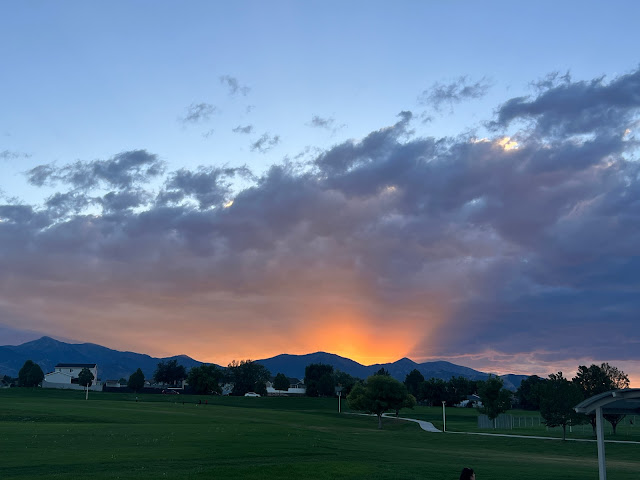We had an interesting discussion in ward council about ministering. The bishop was saying how a lot of ministering is happening organically among ward members—people are loving and serving and helping each other—but ministering assignments are not necessarily getting done. Then someone else brought up how he's talked to a lot of people who feel guilty all the time because even though they are doing so many good things—giving rides to a neighbor's kids', delivering a meal, sending an encouraging text message—they feel like it doesn't "count" somehow if they aren't ministering to the people they're "supposed" to minister to.
I can relate to that feeling a little bit, because ministering is something you always feel like you can do better, and it's easy to focus on what more you should (always!) be doing and forget the good you ARE doing. And I also know that so many people are good and do good. So many people serve quietly, without assignment and without notice. And obviously that kind of service does count with God; it is so important to Him! He sees it and appreciates it.
But. I've also been thinking about that "ministering gap"
Elder Gong talked about, where people think they're doing enough ministering, but those they "minister" to aren't actually feeling it. And I've been thinking about how many times lately I've heard leaders tell us to
do more ministering—not less. More. And to do it
face to face, in people's homes.
And I've been reflecting on how, despite my own desires to "be good and do good," life just gets so busy and so pressing that unless I have an assignment and feel a sense of duty, I often just don't
manage to find time for spontaneous service and involvement with others' lives.
So, I don't know. I don't know if, as a church, we're pressing too hard or doing too much or doing too little. I don't know if, as a church, we're managing "higher and holier" in our ministering—or not. But I do think I am personally more aware of the importance of ministering than I used to be—more committed to it—and I have more of a desire than I used to. Of course I make an effort partly because I "should." But mostly because I want to…and the concepts of should and want to don't seem as far apart as they used to, either.
Furthermore, I love the way our church handles ministering. To me, ministering assignments distill my vague feeling of "desire to serve" down into an easy channel for action! They give me a way to serve others that's manageable and personal. They help me reach out to women I might not naturally have been drawn to, and they help me learn to love those women. In my last two wards, I can think of at least 16 women I have awkwardly reached out to, served, laughed and cried with, and eventually felt a true connection with—purely through ministering. There is no possible way I would have just spontaneously, out of my good desires, found and befriended all these women on my own. It's miraculous! Of course I try to minister to others in my path too—neighbors, friends, people I have stewardship over, people I work with in my calling. But it really comforts me to know that because I have a ministering assignment (and so does everyone else), no one ought to be overlooked.
That was a very long preface to two quotes I liked from
President Faust's talk to the Priesthood brethren. This whole session was so good—just a classic, wonderful, old Priesthood Session (I miss those!). Elder Ballard gave the "Raise the Bar" talk about missionary work. President Hinckley gave one of his awesome, hard-hitting "rise up and be men!" talks. And President Faust, quoting David O. McKay, said this:
“The very essence of Priesthood is eternal. As it finds expression in life it manifests power. We can conceive of the power of Priesthood as being potentially existent as an impounded reservoir of water. Such power becomes dynamic and productive of good only when the liberated force becomes active in valleys, fields, gardens and happy homes; so the principle of power is manifested only as it becomes active in the lives of men, turning their hearts and desires toward God, and prompting service to their fellow men.”
If we aren’t serving others, then the priesthood really doesn’t benefit us because it is not a passive power. Brethren, be generous with the power of blessing which comes through the priesthood, especially to members of your own family. Remember that the Lord has said, “Whomsoever you bless I will bless.”
That's what I feel about the ministering assignments I've been given. They help unlock the power I ought to be using all the time to serve others. My calling does the same thing, and so does my role as a mother, of course. All those divinely-given roles give me a place to keep my covenants and a way to demonstrate my commitment to God. Obviously I don't always live up to those covenants, but I'm so grateful for at least the chance to put them into action! Then I loved what President Faust said to sum it all up:
The Master taught us that “whosoever shall compel thee to go a mile, go with him twain.” Some of the most rewarding times of our lives are those “extra mile” hours given in service when the body says it wants to relax, but our better self emerges and says, “Here am I; send me.”
I've found that to be true! Of course I fall short of the mother, wife, friend, and ministering sister I want to be. But it's rewarding to even make the effort!
























































